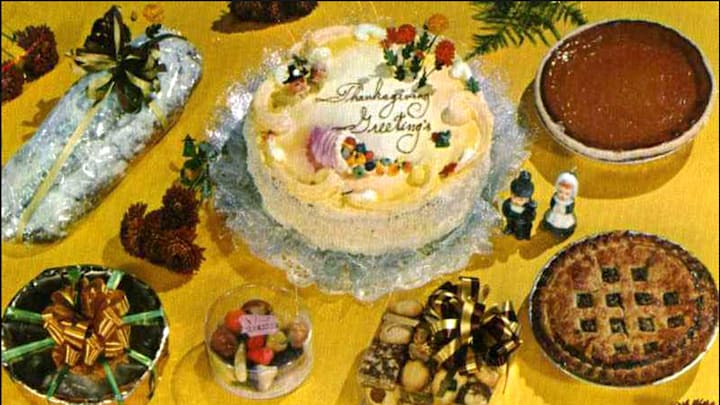Thanksgiving is a time to come together and embrace traditions. But have you thought about how today’s classic dishes first became festive favorites, and which alternatives fell out of fashion? Here are a few historical recipes, featuring olde-timey takes on some of the Thanksgiving dishes that we know and love, that are ripe for a comeback.
- Devilled Turkey
- Cranberry Wine
- Ragoût of Turkey
- Roast Duck with Currant Jelly
- Stuffing with Oysters
- Truffle and Chestnut Stuffing
- Sweet Potato Balls
- Green Bean Pudding
- Pumpkin Pudding
- Vinegar Pie
Devilled Turkey
Want to spice up your bird this Thanksgiving? Look no further than this 1878 recipe from Marion Cabell Tyree’s book, Housekeeping in Old Virginia. The recipe calls for the poultry to be broiled slowly, and then covered with a sauce made of equal parts pepper vinegar, mustard, acid fruit jam, and celery sauce. This latter ingredient was popular in the 19th century, and was even produced by Heinz, winning first prize at Chicago’s World’s Columbian Exposition in 1893.
Cranberry Wine
If you’re looking for drink pairing for your turkey, Marion Harland’s 1873 book Common Sense in the Household has you covered. With 1 quart of water and 2 quarts of ripe, mashed berries, you’ll be on your way to recreating her old-timey cranberry wine. You’ll need to let the mixture stand for two days before straining it, adding more fruit and steeping again, followed by another strain and then boiling. And don’t forget to have “lightly covered jars” on hand for the fermentation. According to the author, the beverage is “said to be very good for scrofula”—a form of tuberculosis.
Ragoût of Turkey

Turkey leftovers are a mainstay of the fall season, and Harland has the perfect solution. Common Sense in the Household offers a warming winter recipe for a turkey ragoût (a dish of chopped meat stewed with vegetables). It combines bite-sized pieces of roast turkey in a sauce of leftover gravy, cloves, nutmeg, cranberry jelly, and a glass of brown sherry or Madeira. “Leave out the stuffing entirely,” Harland warns. “It is no improvement to the flavor, and disfigures the appearance of the ragoût.”
Roast Duck with Currant Jelly
Though turkey takes center stage on many modern Thanksgiving dinner tables, it wasn’t always that way: Early American Thanksgiving meals are likely to have featured duck, goose, or other birds instead. For those interested in an alternative bird, Juliet Corson’s 1885 New Family Cook Book has plenty of inspiration. Corson’s recipe for duck with currant jelly calls for the duck to be stuffed with herbed mashed potatoes, roasted until “very brown,” and served with equal amounts of currant jelly and butter.
Stuffing with Oysters
Stuffing is a comforting treat, and while modern consumers might find an addition of oysters to be decadent, they were popular with poorer families in days gone by: Oysters were a cheap and plentiful protein. In the Folger Shakespeare Library collection, an anonymous manuscript cookbook from the early modern period offers a recipe for “stuffing for a boyled Turky” made with oysters. The stewed and chopped oysters are to be combined with suet, bread crumbs, anchovy, lemon peel, mace, nutmeg, salt, and eggs.
Truffle and Chestnut Stuffing

Rufus Estes, a chef for the Pullman Company and U.S Steel companies, published one of the first American cookbooks by a Black chef in 1911. In Good Things To Eat, as suggested by Rufus, he included this recipe for a rich stuffing for roast turkey. The dish calls for chestnuts to be boiled until tender along with a bay leaf, coriander seeds, and some salt. Then the cook adds bacon and truffles with pinches of dried thyme and marjoram. Estes suggests “toss[ing] the mixture for a few minutes longer over the fire.”
Sweet Potato Balls
Indigenous people in the Americas grew sweet potatoes as a food crop well before the arrival of Europeans in 15th century, and they remain a favorite side dish today. In Fannie Farmer’s 1901 book, The Boston Cooking-School Cook Book, she shares a recipe for sweet potato balls. These deep-fried nuggets call for ricing the potatoes, which will result in an extra-smooth and lump-free texture. The hot riced sweet potato is combined with butter, salt, pepper, and egg, rolled into balls, and fried in this comforting vintage take on an enduring classic.
Green Bean Pudding
The trusty green bean casserole topped with fried onions was created by Campbells Test Kitchen chef Dorcas Reilly in 1955—but there are plenty of older renditions of green bean dishes in the depths of historic cookbook collections. In A New System Of Domestic Cookery, an 1807 cookbook by Maria Eliza Ketelby Rundell, you’ll find a recipe that is ideal for using up those old beans that are left over after Thanksgiving meal prep. According to the recipe, beans should be boiled, blanched, and combined with salt, pepper, cream, and “the yelk of an egg,” and served with butter, parsley, and bacon.
Pumpkin Pudding

While some modern versions of this tasty fall dessert forego pastry entirely, which makes them easier to bake and lighter to consume than pumpkin pie, Eliza Leslie’s recipe in her 1832 cookbook Seventy-five receipts for pastry, cakes, and sweetmeats calls for the mixture to be put into “puff-paste.” Along with spices, egg, sugar, and stewed pumpkin, Leslie suggests adding a half-glass of mixed wine and brandy and a half-glass of rose water to the pudding.
Vinegar Pie
If you’re looking for a change from the typical pumpkin pie, why not try this confection that harkens from the mid-19th century American frontier? Made in the winter after the fruit supply had been eaten, this recipe includes apple cider vinegar to give the custardy pie filling a fruity flavor. It might sound less than tempting, but some modern iterations of Depression-era vinegar pies include more luxurious ingredients like vanilla extract and honey.
Discover More Thanksgiving Facts:
